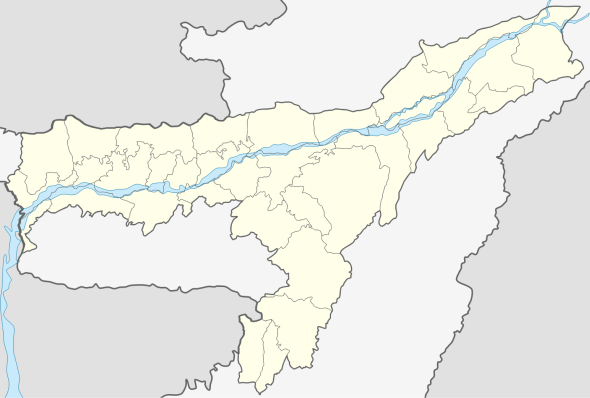Barpathar
| Barpathar বৰপথাৰ | |
|---|---|
| town | |
 Barpathar  Barpathar Location in Assam, India | |
| Coordinates: 26°18′N 93°52′E / 26.3°N 93.87°ECoordinates: 26°18′N 93°52′E / 26.3°N 93.87°E | |
| Country |
|
| State | Assam |
| District | Golaghat |
| Elevation | 99 m (325 ft) |
| Population (2001) | |
| • Total | 7,078 |
| Languages | |
| • Official | Assamese |
| Time zone | IST (UTC+5:30) |
| PIN | 785602 |
| Vehicle registration | AS - 05 - XX - XXXX |
Barpathar is a town and a town area committee in Golaghat district in the state of Assam, India.
Geography
Barpathar is located at 26°18′N 93°52′E / 26.3°N 93.87°E.[1] It has an average elevation of 99 metres (324 feet).
The river Dhanshiri flows on the south-west border of the town dividing it from the town of Barpathar located in the Golaghat District of Assam. To the east to north flows the Doiyang river, skirting the Merapani Reserve Forest.
Climate
The climate ranges from semi-cool September–October to winter months of November to February, temperate months of March–April and sultry summer and rainy season of May to September.
Transport
Railway
The Lumding–Dibrugarh section railway line of Northeast Frontier Railways connecting Guwahati and Dibrugarh divides the town into two to the east and west, with Barpathar Railway Station in the centre.
Road
An arterial road connects Barpathar at the north-west with the District town of Golaghat located at a distance of 44 km to the north-west. The same road connects the town with the National HighWay No 36 to the west linking it by road to Guwahati.
The Uriamghat Road running parallel to the rail line on the east to south connects the town with the crude oil producing area of Uriamghat. Another goes from the east to the east-north to Rengmai on the bank of Doiyang river skirting Merapani Reserve Forest. Yet another goes from the east to the north west connecting it with Jamuguri, Furkating and then to Golaghat. The road coming to the west part of the town from Golaghat runs farther parallel to the rail line to connect it with Sarupathar in the south and then farther south to Naojan and Bokajan.
Economy
Agriculture
The population is mostly agricultural, and comprises various sub-groups of Assamese speaking people: Ahoms, Sutias, Bodos, Kacharis, Misings, Kalitas, Mahantas, and Brahmins. The town has a large percentage of Bengali speaking people and a small fraction of Muslims as also Christians and Buddhists.
Greater Barpathar encompasses a cluster of well-established villages, viz., Dubarani, Baramukhia, Dhundasam,Rengmai, Premhara, Jaljori, Jorhatiya, Pabhajan, Boranagar,Hezari,Sarulangtha, Upperlangtha, Premhara, Nahorani, Sewaguri, Kordoiguri, Singimari, dighali pathar etc. The villages have orchards of coconuts, bananas, pineapples, betel nuts, lichees, paddy fields, sugar cane fields, etc. There is a weekly big bazaar on every Thursday at Barpathar town.
Barpathar is known as the "Granary of Sivasagar". It produces rice, sugarcane, mustards, sesame, fruits and vegetables and tea. The town has a number of tea estates, viz., Pabhajan Tea Estate, Barpathar Tea Estate,Bhuyan Bagan, Dighali Tea Estate, Rengmai Tea Estate, Singimari Tea Estate, Barpathar Tea Estate etc. During the last decade or so the Assamese peasantry has taken to growing tea in their lands thereby pushing up tea production. This has induced setting up of new factories for production of tea in the town.
Industry
The area surrounding Uriamghat produces crude oil, which, partly feeds the Numaligarh Oil Refinery.
Education
Various educational institutions have been set up, namely, Barpathar Higher Secondary School (oldest in the Dhanshri Sub-Division of Golaghat District), Hindi School, Bengali School, Girls High School, Sanskrit Vidyalaya, Industrial Training Institute (ITI) and the Barpathar College. A number of English Medium Schools and a Junior College have been set up in the Town during the last 15 years.
Culture
Every village in the Town has a "Namghar" where the Vaishnava followers meet in the evening to perform nam prasangs offering prayers to Lord Krishna. Various religious Bhawnas (dramas) are also performed in these namghars. Besides, there is also a Sarvajanin Mandap where Durga Puja is performed every year. Bihu Sanmilan held in April each year, in the Hindu Month of Vaishakha (Assamese Bohag) draws a large number of Bihu dancing troupes to the town.
Demographics
As of 2001 India census,[2] Barpathar had a population of 7078. Males constitute 53% of the population and females 47%. Barpathar has an average literacy rate of 78%, higher than the national average of 59.5%; with 56% of the males and 44% of females literate. 12% of the population is under 6 years of age.
As per 2011 Census of India Report the Barpathar town is divided into 4 wards for which elections are held every 5 years. The Barpathar Town Committee has population of 7,657 of which 3,968 are males while 3,689 are females as per report released by Census India 2011.
Population of Children with age of 0-6 is 761 which is 9.94% of total population of Barpathar (TC). In Barpathar Town Committee, Female Sex Ratio is of 930 against state average of 958. Moreover, Child Sex Ratio in Barpathar is around 888 compared to Assam state average of 962. Literacy rate of Barpathar city is 89.40% higher than state average of 72.19%. In Barpathar, Male literacy is around 92.57% while female literacy rate is 86.01%.
References
- ↑ Falling Rain Genomics, Inc - Barpathar
- ↑ "Census of India 2001: Data from the 2001 Census, including cities, villages and towns (Provisional)". Census Commission of India. Archived from the original on 2004-06-16. Retrieved 2008-11-01.